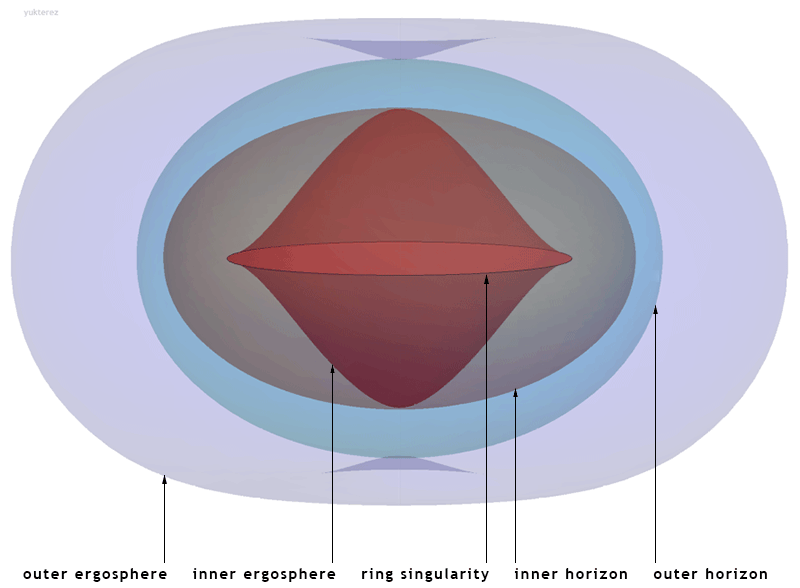|
Near-horizon Metric
The near-horizon metric (NHM) refers to the near-horizon limit of the global metric of a black hole. NHMs play an important role in studying the geometry and topology of black holes, but are only well defined for extremal black holes. NHMs are expressed in Gaussian null coordinates, and one important property is that the dependence on the coordinate r is fixed in the near-horizon limit. NHM of extremal Reissner–Nordström black holes The metric of extremal Reissner–Nordström black hole is :ds^2\,=\,-\Big(1-\frac\Big)^2\,dt^2+\Big(1-\frac\Big)^dr^2+r^2\,\big(d\theta^2+\sin^2\theta\,d\phi^2 \big)\,. Taking the near-horizon limit :t\mapsto \frac\,,\quad r\mapsto M+\epsilon\,\tilde\,,\quad \epsilon\to 0\,, and then omitting the tildes, one obtains the near-horizon metric :ds^2=-\frac\,dt^2+\frac\,dr^2+M^2\,\big(d\theta^2+\sin^2\theta\,d\phi^2 \big) NHM of extremal Kerr black holes The metric of extremal Kerr black hole (M=a=J/M) in Boyer–Lindquist coordinates can be ... [...More Info...] [...Related Items...] OR: [Wikipedia] [Google] [Baidu] |
Black Hole
A black hole is a region of spacetime where gravity is so strong that nothing, including light or other electromagnetic waves, has enough energy to escape it. The theory of general relativity predicts that a sufficiently compact mass can deform spacetime to form a black hole. The boundary of no escape is called the event horizon. Although it has a great effect on the fate and circumstances of an object crossing it, it has no locally detectable features according to general relativity. In many ways, a black hole acts like an ideal black body, as it reflects no light. Moreover, quantum field theory in curved spacetime predicts that event horizons emit Hawking radiation, with the same spectrum as a black body of a temperature inversely proportional to its mass. This temperature is of the order of billionths of a kelvin for stellar black holes, making it essentially impossible to observe directly. Objects whose gravitational fields are too strong for light to escape were fi ... [...More Info...] [...Related Items...] OR: [Wikipedia] [Google] [Baidu] |
Topology
In mathematics, topology (from the Greek words , and ) is concerned with the properties of a geometric object that are preserved under continuous deformations, such as stretching, twisting, crumpling, and bending; that is, without closing holes, opening holes, tearing, gluing, or passing through itself. A topological space is a set endowed with a structure, called a ''topology'', which allows defining continuous deformation of subspaces, and, more generally, all kinds of continuity. Euclidean spaces, and, more generally, metric spaces are examples of a topological space, as any distance or metric defines a topology. The deformations that are considered in topology are homeomorphisms and homotopies. A property that is invariant under such deformations is a topological property. Basic examples of topological properties are: the dimension, which allows distinguishing between a line and a surface; compactness, which allows distinguishing between a line and a circle; connectedne ... [...More Info...] [...Related Items...] OR: [Wikipedia] [Google] [Baidu] |
Extremal Black Hole
In theoretical physics, an extremal black hole is a black hole with the minimum possible mass that is compatible with its charge and angular momentum. The concept of an extremal black hole is theoretical and none have thusfar been observed in nature. However, many theories are based on their existence. In supersymmetric theories, extremal black holes are often supersymmetric: they are invariant under several supercharges. This is a consequence of the BPS bound. Such black holes are stable and emit no Hawking radiation. Their black hole entropy can be calculated in string theory. It has been suggested by Sean Carroll that the entropy of an extremal black hole is equal to zero. Carroll explains the lack of entropy by creating a separate dimension for the black hole to exist within. The Hawking radiation of extremal black holes are considered non-thermal (non-Planck distributed), with no associated temperature. The hypothetical black hole electron is super-extremal (having ... [...More Info...] [...Related Items...] OR: [Wikipedia] [Google] [Baidu] |
Reissner–Nordström Metric
In physics and astronomy, the Reissner–Nordström metric is a static solution to the Einstein–Maxwell field equations, which corresponds to the gravitational field of a charged, non-rotating, spherically symmetric body of mass ''M''. The analogous solution for a charged, rotating body is given by the Kerr–Newman metric. The metric was discovered between 1916 and 1921 by Hans Reissner, Hermann Weyl, Gunnar Nordström and George Barker Jeffery independently. The metric In spherical coordinates (t, r, \theta, \varphi), the Reissner–Nordström metric (i.e. the line element) is ds^2=c^2\, d\tau^2 = \left( 1 - \frac + \frac \right) c^2\, dt^2 -\left( 1 - \frac + \frac \right)^ \, dr^2 - r^2 \, d\theta^2 - r^2\sin^2\theta \, d\varphi^2, where c is the speed of light, \tau is the proper time, t is the time coordinate (measured by a stationary clock at infinity), r is the radial coordinate, (\theta, \varphi) are the spherical angles, and r_\text is the Schwarzschil ... [...More Info...] [...Related Items...] OR: [Wikipedia] [Google] [Baidu] |
Kerr Metric
The Kerr metric or Kerr geometry describes the geometry of empty spacetime around a rotating uncharged axially symmetric black hole with a quasispherical event horizon. The Kerr metric is an exact solution of the Einstein field equations of general relativity; these equations are highly non-linear, which makes exact solutions very difficult to find. Overview The Kerr metric is a generalization to a rotating body of the Schwarzschild metric, discovered by Karl Schwarzschild in 1915, which described the geometry of spacetime around an uncharged, spherically symmetric, and non-rotating body. The corresponding solution for a ''charged'', spherical, non-rotating body, the Reissner–Nordström metric, was discovered soon afterwards (1916–1918). However, the exact solution for an uncharged, ''rotating'' black hole, the Kerr metric, remained unsolved until 1963, when it was discovered by Roy Kerr.Melia, Fulvio (2009). "Cracking the Einstein code: relativity and the birth of b ... [...More Info...] [...Related Items...] OR: [Wikipedia] [Google] [Baidu] |
Boyer–Lindquist Coordinates
In the mathematical description of general relativity, the Boyer–Lindquist coordinates are a generalization of the coordinates used for the metric of a Schwarzschild black hole that can be used to express the metric of a Kerr black hole. The Hamiltonian for test particle motion in Kerr spacetime is separable in Boyer–Lindquist coordinates. Using Hamilton–Jacobi theory one can derive a fourth constant of the motion known as Carter's constant. The 1967 paper introducing Boyer–Lindquist coordinates was a posthumous publication for Robert H. Boyer, who was killed in the 1966 University of Texas tower shooting. Line element The line element for a black hole with a total mass equivalent M, angular momentum J, and charge Q in Boyer–Lindquist coordinates and natural units (G=c=1) is : ds^2 = -\frac\left(dt - a \sin^2\theta \,d\phi \right)^2 +\frac\Big(\left(r^2+a^2\right)\,d\phi - a \,dt\Big)^2 + \fracdr^2 + \rho^2 \,d\theta^2 where :\Delta = r^2 - 2Mr + a^2 + Q^2, called th ... [...More Info...] [...Related Items...] OR: [Wikipedia] [Google] [Baidu] |
Kerr–Newman Metric
The Kerr–Newman metric is the most general asymptotically flat, stationary solution of the Einstein–Maxwell equations in general relativity that describes the spacetime geometry in the region surrounding an electrically charged, rotating mass. It generalizes the Kerr metric by taking into account the field energy of an electromagnetic field, in addition to describing rotation. It is one of a large number of various different electrovacuum solutions, that is, of solutions to the Einstein–Maxwell equations which account for the field energy of an electromagnetic field. Such solutions do not include any electric charges other than that associated with the gravitational field, and are thus termed vacuum solutions. This solution has not been especially useful for describing astrophysical phenomena, because observed astronomical objects do not possess an appreciable net electric charge, and the magnetic fields of stars arise through other processes. As a model of realistic black ... [...More Info...] [...Related Items...] OR: [Wikipedia] [Google] [Baidu] |
Stationary Black Hole
In Einstein's theory of general relativity, the Schwarzschild metric (also known as the Schwarzschild solution) is an exact solution to the Einstein field equations that describes the gravitational field outside a spherical mass, on the assumption that the electric charge of the mass, angular momentum of the mass, and universal cosmological constant are all zero. The solution is a useful approximation for describing slowly rotating astronomical objects such as many stars and planets, including Earth and the Sun. It was found by Karl Schwarzschild in 1916, and around the same time independently by Johannes Droste, who published his more complete and modern-looking discussion four months after Schwarzschild. According to Birkhoff's theorem, the Schwarzschild metric is the most general spherically symmetric vacuum solution of the Einstein field equations. A Schwarzschild black hole or static black hole is a black hole that has neither electric charge nor angular momentum. A ... [...More Info...] [...Related Items...] OR: [Wikipedia] [Google] [Baidu] |
Intrinsic Metric
In the mathematical study of metric spaces, one can consider the arclength of paths in the space. If two points are at a given distance from each other, it is natural to expect that one should be able to get from the first point to the second along a path whose arclength is equal to (or very close to) that distance. The distance between two points of a metric space relative to the intrinsic metric is defined as the infimum of the lengths of all paths from the first point to the second. A metric space is a length metric space if the intrinsic metric agrees with the original metric of the space. If the space has the stronger property that there always exists a path that achieves the infimum of length (a geodesic) then it is called a geodesic metric space or geodesic space. For instance, the Euclidean plane is a geodesic space, with line segments as its geodesics. The Euclidean plane with the origin removed is not geodesic, but is still a length metric space. Definitions Let ( ... [...More Info...] [...Related Items...] OR: [Wikipedia] [Google] [Baidu] |
Isothermal Coordinates
In mathematics, specifically in differential geometry, isothermal coordinates on a Riemannian manifold are local coordinates where the metric is conformal to the Euclidean metric. This means that in isothermal coordinates, the Riemannian metric locally has the form : g = \varphi (dx_1^2 + \cdots + dx_n^2), where \varphi is a positive smooth function. (If the Riemannian manifold is oriented, some authors insist that a coordinate system must agree with that orientation to be isothermal.) Isothermal coordinates on surfaces were first introduced by Gauss. Korn and Lichtenstein proved that isothermal coordinates exist around any point on a two dimensional Riemannian manifold. By contrast, most higher-dimensional manifolds do not admit isothermal coordinates anywhere; that is, they are not usually locally conformally flat. In dimension 3, a Riemannian metric is locally conformally flat if and only if its Cotton tensor vanishes. In dimensions > 3, a metric is locally conformally fla ... [...More Info...] [...Related Items...] OR: [Wikipedia] [Google] [Baidu] |
General Relativity
General relativity, also known as the general theory of relativity and Einstein's theory of gravity, is the geometric theory of gravitation published by Albert Einstein in 1915 and is the current description of gravitation in modern physics. General relativity generalizes special relativity and refines Newton's law of universal gravitation, providing a unified description of gravity as a geometric property of space and time or four-dimensional spacetime. In particular, the ' is directly related to the energy and momentum of whatever matter and radiation are present. The relation is specified by the Einstein field equations, a system of second order partial differential equations. Newton's law of universal gravitation, which describes classical gravity, can be seen as a prediction of general relativity for the almost flat spacetime geometry around stationary mass distributions. Some predictions of general relativity, however, are beyond Newton's law of universal gr ... [...More Info...] [...Related Items...] OR: [Wikipedia] [Google] [Baidu] |




